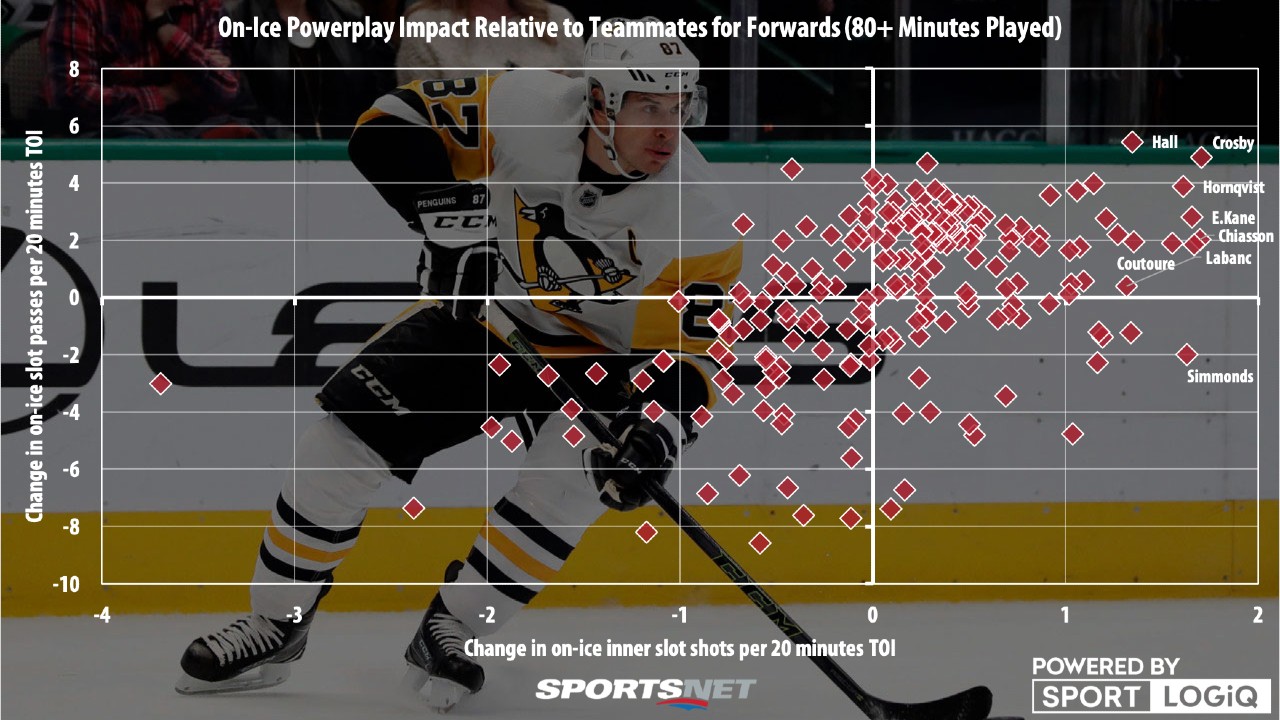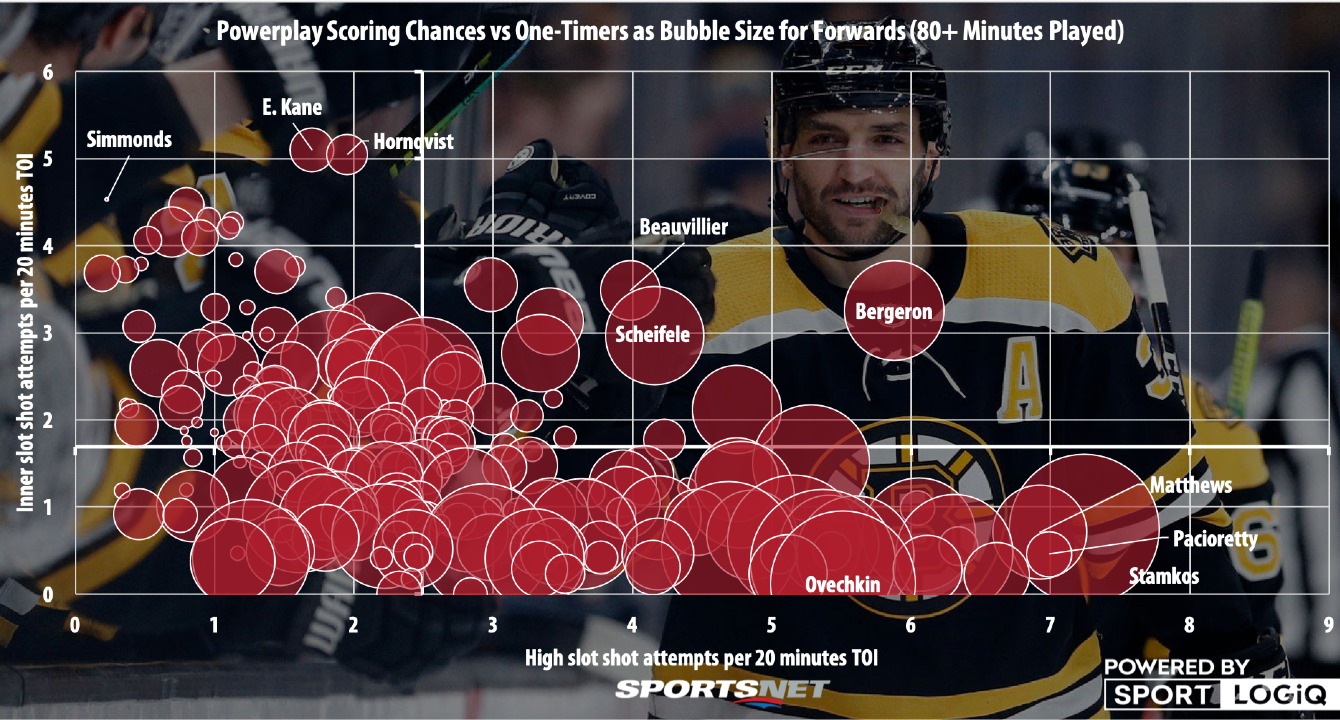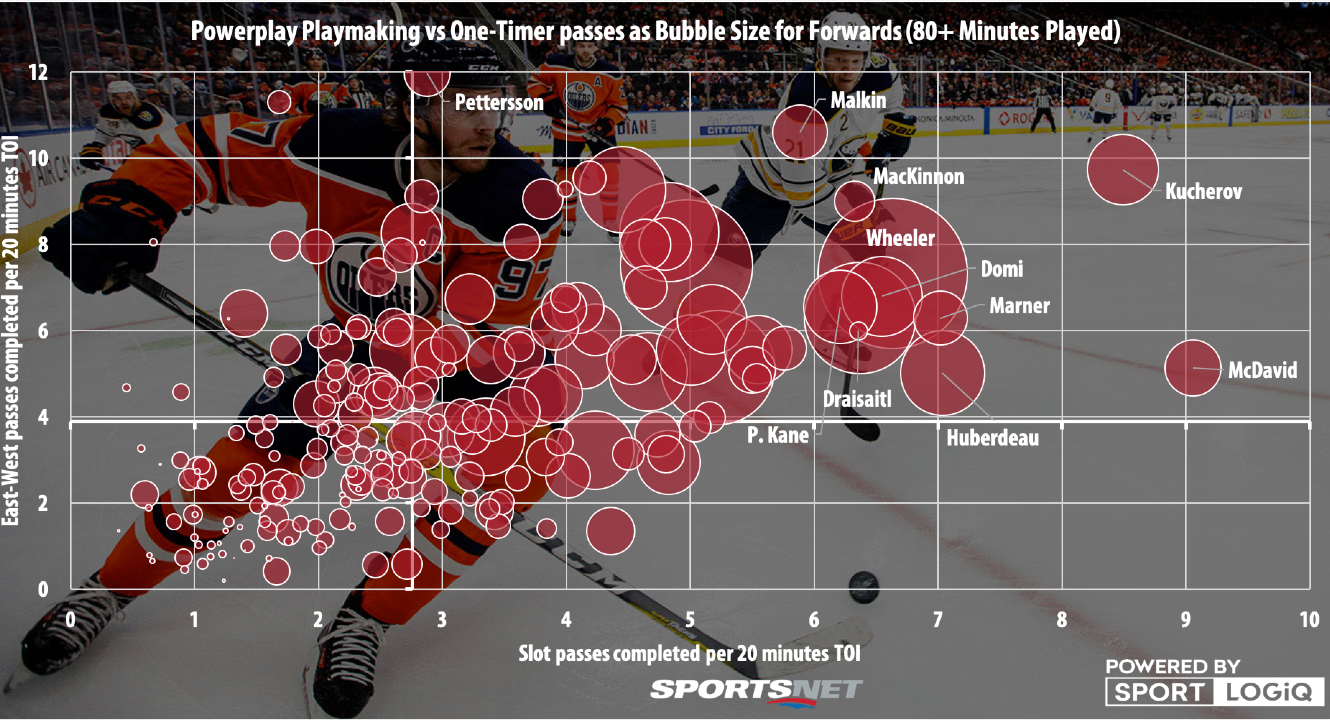Whether it’s shooters, playmakers, or the defensive-zone breakout kings, we’ve taken some good looks at even-strength offence in the NHL this season, re-visiting three examinations we started in pre-season using data from 2018-19.
With our venture into previously examined territory and updates for this season complete, it’s time to do something new, but in the same style of analysis. Let’s look at the power play.
My first instinct when looking at power plays was to see if there was a way to give a full view of which forwards create the most offence with the man advantage, but the trouble with power plays is that they’re very tied to strategy more than simply just a talented player breaking through an opponent’s defence. Often this means players have extremely specific roles in which they can excel, but not necessarily rack up the numbers in the underlying offensive metrics.
For example, a net-front presence will get lots of shots from the inner slot, but they won’t look great from the high slot, they won’t get many one-timers, and they won’t make many great passes either. That doesn’t mean they aren’t vitally important and highly impactful, but with the man advantage we may need to start out in the general sense and then compartmentalize to show specific strengths, rather than say one player is ‘the best.’
Starting out in the general sense, let’s take a look at which forwards have the strongest on-ice impact on their teams’ power plays in creating the highest quality plays relative to when they’re not on the ice. There’s much less power-play time than 5-vs-5 time obviously, so we’ll limit the sample to forwards who have played at least 80 minutes while up a man.

Looking at things this way, there are some advantages and disadvantages. On the good side, you get to control for how strong a team’s power play is overall and avoid just having all the players from the league’s top power play-unit at the top. On the bad side, you do see some issues like one very good power-play unit on a team standing head and shoulders above another not very good unit.
You can see in San Jose, for example, that the Sharks’ entire top unit is rated crazy well on a relative scale, which is helped by the injuries the team has suffered, with a second unit before the season was suspended consisting of Stefan Noesen, Marcus Sorensen, and Noah Gregor. Easier to stand out in that situation.
Overall, the highest impact player for on-ice offence is Sidney Crosby, which is a name that makes sense, and a top-end net-front presence in Patric Hornqvist is right there with him.
Taylor Hall also comes across extremely well both in New Jersey and in Arizona, with the biggest impact on slot passes relative to teammates of any forward in the league. Hall is both an incredible playmaker and someone who draws defenders towards him to create space for others, so that makes a lot of sense.
On the other hand, there’s some weird stuff that pops up, like Alex Chiasson having among the best on-ice impacts on the power play this season, but despite what you may think he’s been pretty good there. Still, there’s likely a lot of noise in there from Connor McDavid and Leon Draisaitl that throws everything off.
Wayne Simmonds remains an incredible driver of net-front shots, though his teams tend to struggle on passing plays with him on the ice as well, which isn’t necessarily his fault but could be an indication that his teammates are looking for tips or rebounds instead of puck movement while he’s on the ice.
As expected, in a general look we haven’t solved anything, so let’s compartmentalize and look at shooters.

I did something a little different this time in order to show more data, with the usual setup of two metrics on the two axes set at the league average for each, but this time each player’s data point is in bubble form, with the size of the bubble representing the percentage of their shots on goal that are one-timers.
Doing this, we can see how certain players can beat their expected goals based on either volume or shot location selection. Alex Ovechkin for example, does not produce the shot volume on the power play that he does at even strength. He doesn’t pinch into the net front like he does at 5-vs-5 either, preferring to stick to his ‘Ovi spot’ or even drift up to the point in swapping spots with John Carlson.
Ovi gets a fair amount of shots from the high slot, but the biggest factor in his scoring is that a whopping 62.4 per cent of his shots are one-timers, three times the league average.
Steven Stamkos is the league leader in that area, with 64.3 per cent of his shots being one-timers, and he also leads all players in shot attempts from the high slot per 20 minutes of power-play time. As scary as Tampa Bay has looked in the second half of this season, Stamkos has been startlingly unlucky in his power-play shooting.
From the inner slot, you can see there are fewer one-timers as a natural function of it being more difficult to complete passes to that area and more difficult to wind up with the limited space available to shoot from. Evander Kane and Hornqvist lead the pack in inner slot shots, and Simmonds is that tiny dot with the third-most inner slot shot attempts, but only two per cent of his shots on goal are one-timers.
There aren’t many players who can take a truly balanced approach at shooting from the slot on the power play because of how defined roles are, but the best among them is Patrice Bergeron. Bergeron is able to cover the whole slot area, attacking from the high slot with a strong 43 per cent of his shots being one-timers, and pinching into the net front to bang home chances often, as I’m sure Leafs fans can attest to.
Mark Scheifele and Anthony Beauvillier play similar styles to Bergeron on the power play, though neither are able to equal his shot volume.
Next up, let’s look at the playmakers.

With the same idea in mind that we used for shooters, with the axes set at league averages, we can contrast slot passes with east-west passes for forwards, with the size of the bubbles for each player representing the number of completed one-timer passes they make every 20 minutes.
McDavid is the league’s best forward at completing slot passes, which isn’t a huge surprise, but just like when we looked at his own one-timers at even strength, his team is letting him down at releasing those shots quickly.
Vancouver’s Elias Pettersson is the reverse McDavid, with just a slightly above league average number of slot passes, but leading all forwards in full, cross-ice East-West passes. Like McDavid though, his team is letting him down and not releasing those pucks quickly enough to create tons of one-timers.
Between those two players you have the most versatile group that’s able to complete both slot passes and East-West passes in about equal measure, with the best of all of them being Nikita Kucherov. What makes Kucherov such a weapon on the power play is that he can hit those dangerous passes to any space, and he’s dangerous shooter on top of it all.
Behind Kucherov you have a group of elite playmakers all bunched together in Evgeni Malkin, Nathan MacKinnon, Max Domi, Patrick Kane, Mitch Marner, Draisaitl, Jonathan Huberdeau, and Blake Wheeler.
The one that stands out the most to me, though, is Wheeler. He is a versatile playmaker anyway, and has been a top-two presence in scoring-chance creation on the power play with Claude Giroux over the last four seasons, but it’s how well Wheeler has his passes converted into one-timers that’s truly impressive.
Wheeler’s passes turn into one-timers on net 7.4 times every 20 minutes, which is nearly five times the league average. Whether it’s the right cast of supporting players to convert them or a special quality to Wheeler’s vision or pass placement, that’s incredible.
Who is ‘the best’ is going to be highly subjective here, but seeing how the data can visualize different playing styles and isolate those who are effective within them is always interesting.
[relatedlinks]








